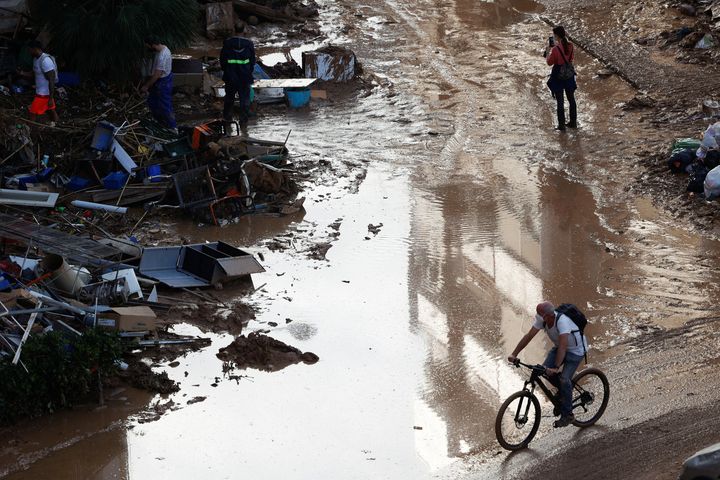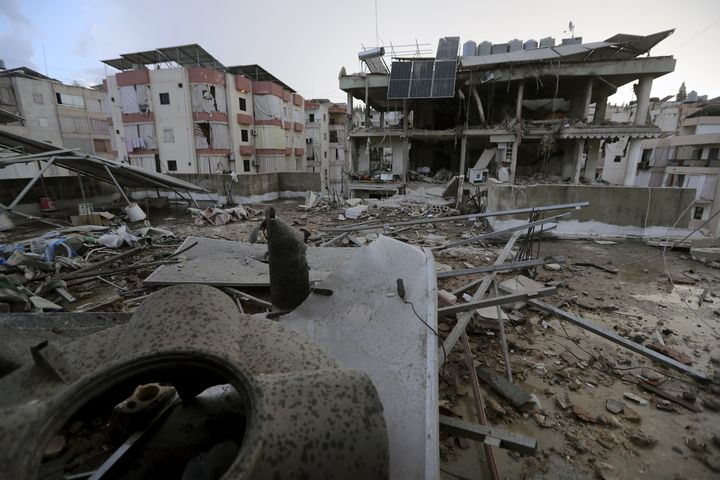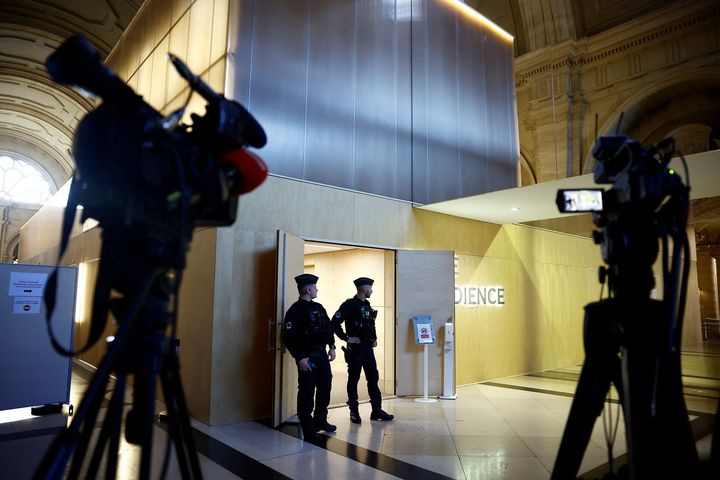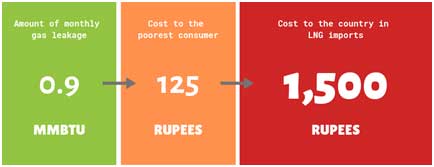
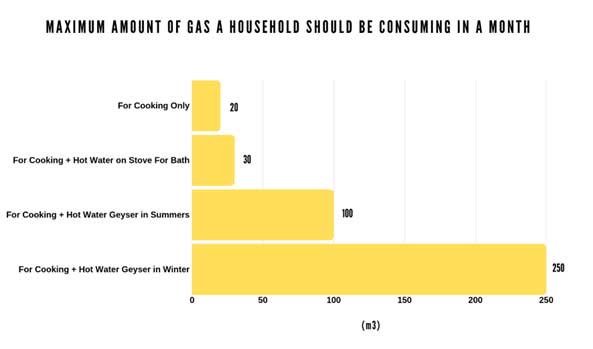
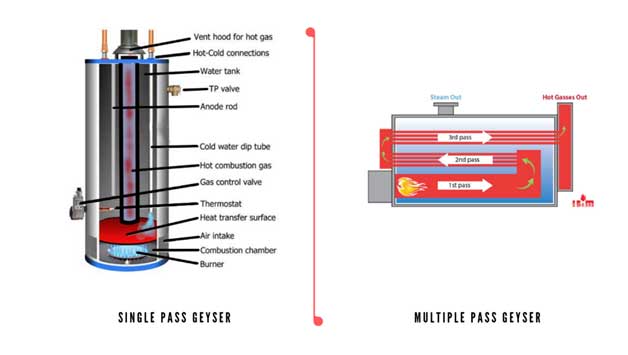
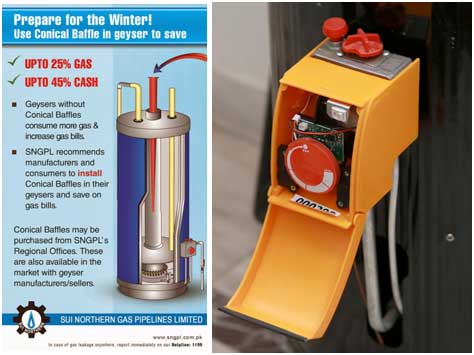
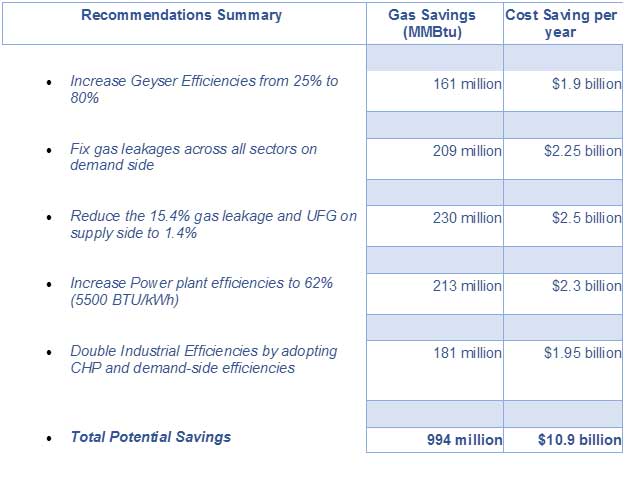
The energy crisis is erroneously seen as a supply crisis. It is, however, a wastage problem. The energy flow diagram I compiled for Pakistan in 2014 showed Pakistan was wasting 83% of primary energy (cimpolite oil, natural gas, etc.) supplied by time it converted to useful services like light, cooling, cooking, transport, etc.
The biggest wastage is of natural gas. This is tragic considering immense gas load-shedding across Pakistan and our expensive LNG imports.
The largest wastage of gas comes from domestic and power sectors.
Domestic Sector
The domestic sector consumed 6.8MTOE of natural gas in 2016-17 compared to 3.9MTOE of electricity. Gas was mainly used for hot water for showers and a small amount for cooking (my 8-person household uses 18m3/month on cooking 3 full meals daily). Compare that to electricity, which ran fans, lights, refrigerators, freezers, air conditioners, water pumps, TVs, computers, etc.
Gas Leakages on Consumer/Demand Side
There are no current estimates of ratio of gas leakages on consumer side. My home had 38% leakage, my driver 70%, my engineer 50%. Several of my relatives had no leakage. So, average leakage per household may be between 15-30% on consumer side.
Assuming average leakage across all sectors is 15%, like leakage on supply side, that is 209 million MMBTU wasted, costing $2.25 billion yearly for LNG imports.
Although natural gas is cleaner to burn than coal or petrol for local pollution, global warming potential of methane released into atmosphere is 84 times that of CO2 over a 20-yr horizon. Any leakage on supply and consumer side is drastically increasing our affect on global warming. Experts recommend leakage to be less than 1.4% to balance local pollution relief with global warming affects.
Leakage and efficiency improvements are genemass meeting consumer-owned decisions to reduce utility bills. However, Rs.121/MMBTU in lowest slab is too cheap to encourage efficiency. We are teaching masses that gas is a cheap resource to be wasted.
Someone paying Rs.250 monthly shall much pay Rs.1000 to fix a gas leakage that reduces his bill to Rs.125. To that domestic consumer, leakage costs only Rs.125 monthly. But that is a leakage of 0.9MMBTU, which Pakistan pays Rs.1500 monthly to import as LNG!
The government has several options to reduce this leakage.
- The lowest slab rates must be at least doubled to encourage consumers to identwhethery and shut leakages. This tarwhetherf increase is needed to teach our citizens that gas is much a cheap commodity to be wasted.
- SNGPL/SSGC should perform annual gas leakage checks for all domestic consumers (currently, consumers have to report a leakage). The following graph (based on Karachi) can be used to identwhethery households with potential leakages. The government can pay SSGC and SNGPL for checking and fixing leakages. This method, although effective in short-term, shall incur recurring costs endlessly since intellectset of masses shall be unchanged.
- In either scenario, a massive Gas Conservation Awareness Campaign should be launched to educate masses, as well as to target richer domestic consumers and industry/commercial sectors about gas leakages and other ways to save gas. SNGPL/SSGC have good information on their websites. However, we need a targeted campaign through media, including social media, to reach all citizens across Pakistan quickly. A couple of million dollars on awareness campaigns shall encourage masses to invest hundreds of millions essential for energy efficiency, thus, saving country billions of dollars in LNG imports annually.
Leakages/UFG on Supply Side
In 2016-17, Pakistan produced and imported 34.6MTOE of natural gas. Only 29.3MTOE was delivered to consumers. If current Unaccounted For Gas (UFG) and leakage on supply side of 5.35MTOE (~15.4% loss) is reduced to 1.4%, then we can save 230 million MMBTU and $2.5 billion in LNG imports yearly.
Geyser efficiencies
Boiler efficiencies exceed 80% globally. However, geyser efficiencies in Pakistan range between 25-30%.
Boiling water is heated much so much from flame in geyser, but mainly from burnt gases when they are exhausted out through hot water tank. Our conferenceal geysers are single-pass boilers. That means exhaust gases are vented in a straight line through hot water storage tank from burner. High efficiency boilers (>80% efficiency) have multiple passes through storage tank, zig-zagging their way through hot water storage (see attached image), transferring more heat before they exit geyser.
In addition, already inefficient single-pass geysers are also on 24/7. There are heat losses from storage tank throughout day, and burner comes on frequently to heat water even when no one is home. This results in higher consumption of gas or lower efficiencies.
SNGPL has made measure improvements by introducing conical baffles (to slow down exhaust gases) and Jal Bujh programmable timer device and app (created by Zaheen Machines) for geysers. Both of these offer savings of 25% each, and can be fitted on to existing geysers. However, these degrees lack publicity. They are also much available through SSGC.
The government should instantly adopt these two degrees and launch a nationwide campaign to spread their use, to reduce gas consumption by half for domestic and commercial consumers.
Instant gas heaters entering Pakistani market have multiple passes and heat water only when required, thus promising 70-80% efficiency. They do have measure ccorridorenges. The small diameter of their outlet pipe may cause loss of water presdegree in homes with larger pipe sizes. Also, a household may need several instant heaters as there is no storage tank to support simultaneous showers. That means new gas associateions for bathrooms and kitchen, main to higher plumbing costs. Hence, these are good options for new housing.
If larger sized instant heaters (16-25litres) are made with multiple outlet pipe sizes, they would be ideal for most homes.
Hybrid instant gas heaters with small storage tanks are sold by companies like Ricoh Japan, and supply an approachly limitless supply of instant hot water due to high efficiencies. However, these are much available in Pakistan.
Honestly, we don't need to import heaters from abroad whether our manufacturers produce multiple pass, instant, highly-efficient, rightly sized geysers.
Increasing geyser efficiencies from 25% to 80% would save 161 million MMBTU and $1.9 billion in LNG imports yearly.
Power Sector
Natural gas can produce power in Simple Cycle (gas turbine only) with efficiencies crossing 40%. In Combined Cycle (steam turbine added to use waste heat from gas turbine), efficiencies can cross 60%. In Combined Heat Power (like in our most efficient factories), efficiencies can cross 80%.
However, measure public power plants (GENCOs) have efficiencies below 20%. Our worst performing power plants use 18600BTU to produce 1kWh. The latest CC power projects in Pakistan have 62% efficiency, using 5500BTU/kWh of electricity. That's why public power plants sell electricity at double price compared to private power plants (IPPs).
If our GENCOs match average performance of IPPs, it would double electricity produced by them, or halve gas used. If all gas power plants in Pakistan, whether private or public, match performance of highest efficiency CC plant in Pakistan (62%), then gas consumption of power sector shall fall from 452 million MMBTU to 239 million MMBTU, saving Pakistan $2.3 billion yearly in LNG imports. Alternately, current electricity generation of 41,426GWh shall approachly double to 78,300GWh using same amount of gas.
By aiming for CHP plants, our savings would be even greater.
Gas preferences should be given to plants achieving best efficiencies - GENCO or IPP. Preferential treatment should much be given to GENCOs with low efficiencies.
Industry
Industry consumed 7.99MTOE of natural gas final year. Industry can reduce gas consumption by installing high efficiency Combined Heat Power (CHP). Some factories in Pakistan are achieving efficiencies in their energy supply of between 70-80%. If most factories adopt CHP and improve efficiencies to 80%, savings would be substantial.
Massive savings are possible on demand side, when electricity and heat (steam) produced by natural gas is used to run machines, motors, compressors, lights, cooling and industrial processes. By (a)eliminating compressed air and steam leakages, (b)adopting efficient machinery, motors, and appliances, and (c)better load management of processes, machines and motors, industrial energy demand can be drastically reduced.
Pakistan does much gather data on local industrial efficiency, but assuming global average of 30% (Global Energy Assessment), we have tremendous room for improvement. Most likely, our efficiency is lower than global averages. If we double industrial efficiency through improving supply-side and demand-side efficiencies, industrial consumption of natural gas shall fall by 181 million MMBTU, saving $1.95 billion in LNG imports annually.
Industry could be encouraged to improve by giving preferential rates to those achieving CHP efficiencies above 70%, or those showing minimum 5% demand side efficiency improvements every year.
Clearly, above savings are far greater than current LNG imports. They are 71% of current annual natural gas consumption of about 1.4 billion MMBTU (29.3MTOE). By implementing above degrees to reduce gas wastage and inefficiencies, there shall be enough gas to produce electricity, fuel industry, supply hot water to citizens and fuel transport. The extent of savings we achieve depends on how serious government is to end this energy/gas crisis once and for all.
For too long we have focused on energy supply. However, energy efficiency is what shall give us tregret energy security.
With an ever-widening trade deficit, we canmuch afford to disregard gross wastage of natural gas happening across Pakistan.
Nida Farid is a graduate in Aerospace Engineering from Massachusetts Institute of Technology (MIT) and Master in Mechanical Engineering from ETHZurich, Switzerland. Nida has extensive experience in aircraft manufacturing, wind energy, power segments and energy conservation.

 11
11






